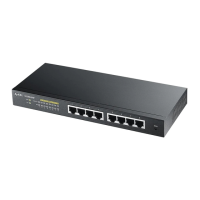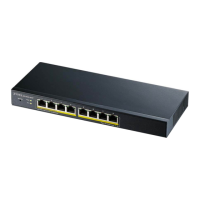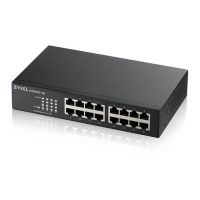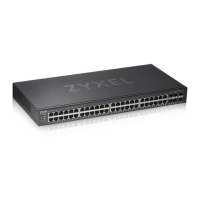Appendix C IPv6
GS1350 Series User’s Guide
397
Subnet Masking
Both an IPv6 address and IPv6 subnet mask compose of 128-bit binary digits, which are divided into
eight 16-bit blocks and written in hexadecimal notation. Hexadecimal uses four bits for each character
(1 ~ 10, A ~ F). Each block’s 16 bits are then represented by 4 hexadecimal characters. For example,
FFFF:FFFF:FFFF:FFFF:FC00:0000:0000:0000.
Interface ID
In IPv6, an interface ID is a 64-bit identifier. It identifies a physical interface (for example, an Ethernet
port) or a virtual interface (for example, the management IP address for a VLAN). One interface should
have a unique interface ID.
EUI-64
The EUI-64 (Extended Unique Identifier) defined by the IEEE (Institute of Electrical and Electronics
Engineers) is an interface ID format designed to adapt with IPv6. It is derived from the 48-bit (6-byte)
Ethernet MAC address as shown next. EUI-64 inserts the hex digits fffe between the third and fourth bytes
of the MAC address and complements the seventh bit of the first byte of the MAC address. See the
following example.
Stateless Auto-configuration
With stateless auto-configuration in IPv6, addresses can be uniquely and automatically generated.
Unlike DHCPv6 (Dynamic Host Configuration Protocol version six) which is used in IPv6 stateful auto-
configuration, the owner and status of addresses don’t need to be maintained by a DHCP server. Every
IPv6 device is able to generate its own and unique IP address automatically when IPv6 is initiated on its
interface. It combines the prefix and the interface ID (generated from its own Ethernet MAC address,
see Interface ID and EUI-64) to form a complete IPv6 address.
When IPv6 is enabled on a device, its interface automatically generates a link-local address (beginning
with fe80).
When the interface is connected to a network with a router and the Switch is set to automatically obtain
an IPv6 network prefix from the router for the interface, it generates
2
another address which combines
its interface ID and global and subnet information advertised from the router. This is a routable global IP
address.
DHCPv6
The Dynamic Host Configuration Protocol for IPv6 (DHCPv6, RFC 3315) is a server-client protocol that
allows a DHCP server to assign and pass IPv6 network addresses, prefixes and other configuration
information to DHCP clients. DHCPv6 servers and clients exchange DHCP messages using UDP.
Table 200
MAC 00 : 13 : 49 : 12 : 34 : 56
Table 201
EUI-64 02 : 13 : 49 : FF : FE : 12 : 34 : 56
2. In IPv6, all network interfaces can be associated with several addresses.

